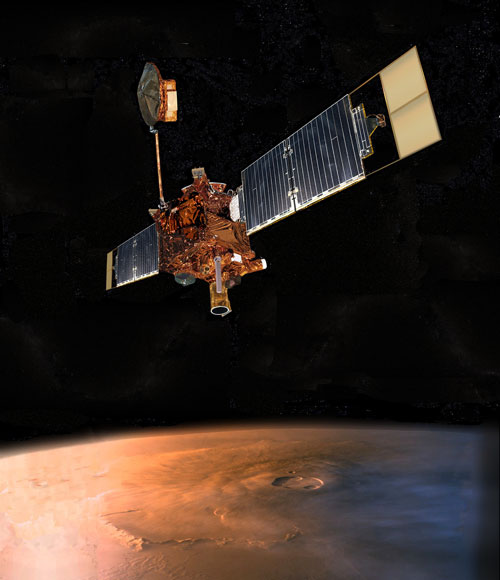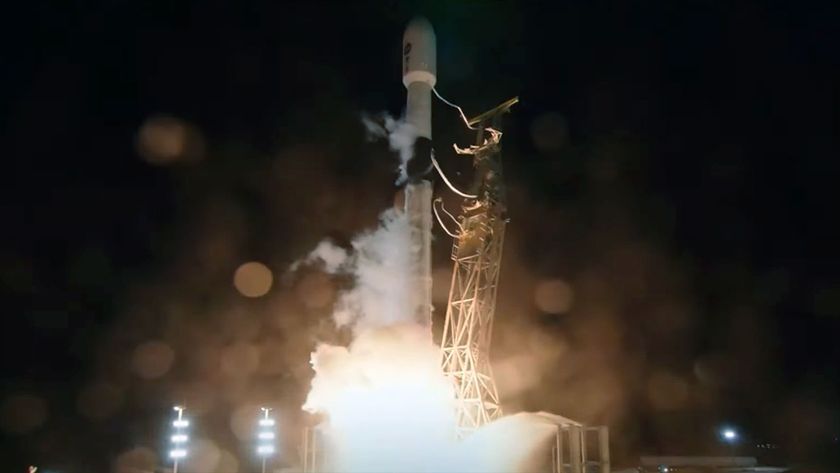Mars Global Surveyor Remains Silent, Feared Lost

BOULDER, Colorado - In ahigh-tech game of celestial hide and seek, a Mars orbiter has tried to image alost-in-space red planet probe.
NASA'sMars Reconnaissance Orbiter (MRO) has been used to attempt locating the space agency'sMars Global Surveyor (MGS)--all in an effort to discern what caused the spacecraft tofall silent several weeks ago.
Butafter using several MRO instruments, the true whereabouts of MGS and itsoverall status are still unknown.
"Wemay have lost a dear old friend and teacher, Mars Global Surveyor," saidMichael Meyer, lead scientist for the Mars Explorations Program at NASAHeadquarters in Washington, D.C.
Meyertook part in an update today from NASA's Jet Propulsion Laboratory (JPL) in Pasadena, California with scientists, engineers and managers detailing the status of theMGS search and the probe's past science accomplishments.
Thebriefing was part-wake, part holding out hope that the errant Mars probe couldstill be heard from again.
No definitive sighting
Get the Space.com Newsletter
Breaking space news, the latest updates on rocket launches, skywatching events and more!
Thelast peep from MGS was on November 5, after notifying ground controllers thatit had problems with a balky solar panel. For weeks, attempts to bring the Marsorbiter back on line were met with a silent response from the misbehavingprobe.
"Inthe last two weeks we have not been able to establish communication with thespacecraft in a normal fashion," said Fuk Li, Mars Program Manager at JPL. Overthat period of time more than 800 command files were sent to re-establishcommunication with MGS, but none of them have been successful, he said.
Tohelp in the search for MGS, the Mars Reconnaissance Orbiter was tasked lastFriday, and again Monday to try and spot the MGS within a select region ofspace.
"Ourpreliminary analysis so far has not yielded any definitive sighting of MGS," Lisaid.
Rover to lend an ear
Anext step is use of the Opportunity Mars rover to listen for a low-powerantenna on MGS. Earth controllers will try today and tomorrow to activate anMGS antenna to transmit a signal to Opportunity, now sitting near VictoriaCrater within Meridiani Planum.
Whateverthe rover picks up--if anything--would be relayed to the Mars Odysseyspacecraft also orbiting the red planet for rebroadcast back to Earth.
JimErickson, JPL project manager for MRO said that analysis of all the MRO searchimagery is still underway. After studying the results from Opportunity's listensession for MGS, as well as other assessments, a decision on utilizing the MRO againwill be weighed, he told SPACE.com.
TomThorpe, Project Manager for the MGS at JPL said that the spacecraft's power canvary considerably if one of its solar panels is turned completely away from theSun - but is also a situation that creates a marginal spacecraft energysituation.
"Thepower could be supported on only one panel. As long as we're getting enoughpower the spacecraft is capable of maintaining itself. We have attitude gas,for example, that could keep us in this mode for one or two years. It'sanybody's guess as to where that stuck panel is pointed...but we feel thatthere's a good chance that we're getting enough power to maintain operations,"Thorpe told SPACE.com.
Old-timer and good friend
TheMars Global Surveyor is an old-timer. In fact, it is the oldest of five NASAspacecraft currently active at the red planet - three orbiting Mars while theSpirit and Opportunity Mars rovers continue duties on the planet's surface.Joining in on the exploration is the Mars Express, also circling Mars and isoperated by the European Space Agency (ESA).
Sofar, NASA has not requested any assistance from ESA to help in the quest tobring MGS back to life.
MGSis a long-lived spacecraft that recently celebrated a decade of spaceexploration after its launch on November 7, 1996. The robust Mars probe has farsurpassed its initial warranty of a full martian year (roughly two Earthyears), yielding a wealth of discoveries over a span of time. MGS had itsmission extended repeatedly, most recently in October of this year.
Intotal, the Mars Global Surveyor program has been a $377 million investment inopening up the red planet to intensive exploration.
"Whilewe have not exhausted everything that we could do...we believe that the prospectof recovery of MGS is not looking very good at all," JPL's Li explained. "It'sbeen a good friend...and we are certainly feeling we might be losing a goodfriend from our family here," he added.
Lisaid that everyone is still holding out some hope, but are fully prepared forthe prospect of never being able to talk to the spacecraft again. "But we arealso fully prepared to celebrate the fact that it has been a job well done," headded.
- Get to Know MRO
- Images: Mars Express: A Year of Discoveries
- NASA Compiles 25,000-Picture Atlas of Mars
- Mars Global Surveyor Stars in New Role
- The 10 Best Mars Images Ever
Join our Space Forums to keep talking space on the latest missions, night sky and more! And if you have a news tip, correction or comment, let us know at: community@space.com.

Leonard David is an award-winning space journalist who has been reporting on space activities for more than 50 years. Currently writing as Space.com's Space Insider Columnist among his other projects, Leonard has authored numerous books on space exploration, Mars missions and more, with his latest being "Moon Rush: The New Space Race" published in 2019 by National Geographic. He also wrote "Mars: Our Future on the Red Planet" released in 2016 by National Geographic. Leonard has served as a correspondent for SpaceNews, Scientific American and Aerospace America for the AIAA. He has received many awards, including the first Ordway Award for Sustained Excellence in Spaceflight History in 2015 at the AAS Wernher von Braun Memorial Symposium. You can find out Leonard's latest project at his website and on Twitter.











